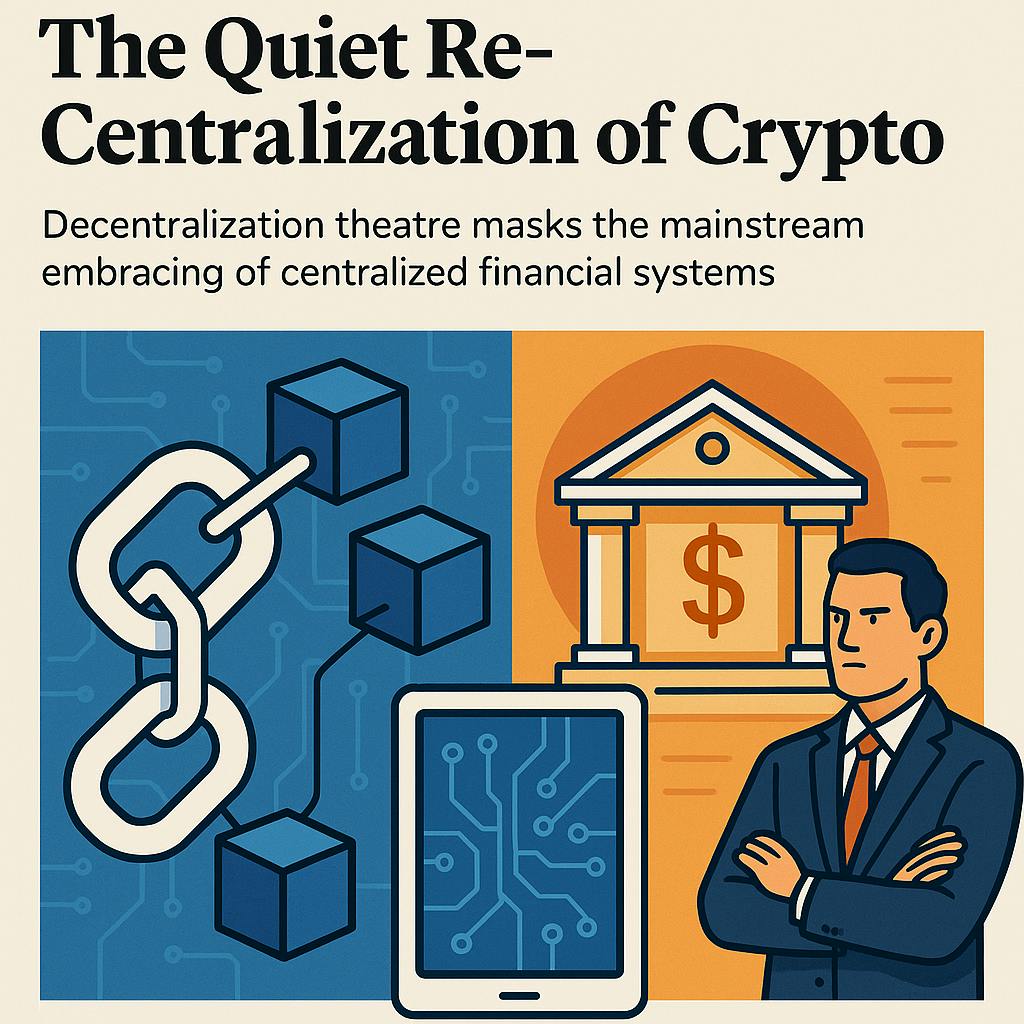Can a cryptocurrency worth over $27 billion finally break into decentralized finance after years of sitting on the sidelines?
That question gained a definitive answer this week as Flare Network launched FAssets on mainnet, specifically targeting XRP holders who have long been excluded from the booming DeFi ecosystem.
The launch of FXRP v1.2 represents more than just another token bridge. It signals a potential paradigm shift for one of cryptocurrency’s oldest and most valuable assets, offering XRP holders their first native path into lending, trading, and yield farming without selling their underlying tokens.
The Bridge Between Legacy and Modern Crypto
FAssets operate as a sophisticated bridging system that transforms non-smart contract cryptocurrencies into DeFi-compatible tokens. Think of it as creating a digital twin of your XRP that can interact with modern blockchain applications while your original XRP remains secure on its native ledger.
The system works through overcollateralization, where independent agents stake more value than the FAssets they help create. This creates multiple layers of security: if an agent fails to fulfill their obligations, their collateral gets liquidated to protect FXRP holders. The process resembles how traditional banks maintain reserves, but with transparent, algorithmic enforcement rather than regulatory oversight. For XRP specifically, this solves a fundamental problem. While Ethereum-based tokens can easily interact with hundreds of DeFi protocols, XRP’s unique consensus mechanism and lack of smart contract functionality has kept it isolated from this $200 billion market. FAssets essentially give XRP a passport to enter DeFi without requiring any changes to the underlying XRP Ledger.
The security approach for FAssets reflects hard-learned lessons from DeFi’s history of exploits and failures. The system underwent four independent security audits from firms including Zellic and Coinspect, alongside community-driven reviews through Code4rena and bug bounty programs via Immunefi. Beyond initial auditing, Flare implemented 24/7 monitoring through Hypernative, a blockchain security firm that provides real-time threat detection. This continuous surveillance model addresses one of DeFi’s persistent vulnerabilities: the gap between launch security and ongoing protection as protocols evolve and face new attack vectors.
The overcollateralization model itself provides additional security layers. Agents must stake significantly more value than the FAssets they enable, creating strong economic incentives for proper behavior. If an agent fails to maintain adequate collateral or fulfill redemption requests, their stake faces liquidation, with proceeds used to protect FXRP holders.
How XRP Enters DeFi
The minting process requires XRP holders to use specific wallets that support both Flare and XRP Ledger functionality, currently limited to Ledger hardware wallets and Bifrost. Users can then interact with platforms like AU or Oracle Daemon to create FXRP tokens.
However, the rollout includes significant constraints. Initial minting caps at 5 million FXRP in the first week, with gradual increases thereafter. This conservative approach aims to stress-test the system with limited exposure before scaling to accommodate broader demand.
Alternative acquisition methods include decentralized exchanges like SparkDEX, BlazeSwap, and Enosys, where users can swap existing Flare network tokens for FXRP. Specialized wallets like Luminite and Oxen Flow will integrate direct swapping functionality, potentially streamlining the user experience for less technical participants.
The Race for Liquidity
Flare’s incentive structure targets specific pools to maximize total value locked and trading activity. The Kinetic FXRP supply pool offers a 5% annual percentage rate, while FXRP/USDT liquidity pools across multiple DEXes target 50% APR through rFLR token rewards.
These incentives follow a familiar DeFi playbook: use token emissions to bootstrap liquidity, then gradually reduce rewards as organic activity develops. The 50% APR targets for liquidity provision seem particularly aggressive, suggesting Flare recognizes the competitive nature of attracting capital in today’s yield-hungry market.
Future integrations promise expanded utility beyond simple trading. Enosys plans to accept FXRP as collateral for its stablecoin system, while upcoming yield markets will incorporate both FXRP and stXRP (liquid staked XRP through Firelight). These developments could create a self-reinforcing cycle where increased utility drives demand, which attracts more liquidity and development.
Opportunity Meets Execution Risk
The addressable market for FXRP appears substantial. XRP’s $27 billion market capitalization represents significant dormant capital that could theoretically flow into DeFi applications. Even capturing 1% of XRP’s supply would create $270 million in total value locked, making FXRP a meaningful DeFi protocol by current standards.
However, execution risks remain considerable. The system’s complexity creates multiple failure points: agent reliability, collateral management, cross-chain communication, and smart contract vulnerabilities all pose potential threats. Previous bridge exploits, including the $320 million Wormhole hack and $190 million Nomad bridge exploit, demonstrate how seemingly secure cross-chain systems can fail catastrophically.
The conservative launch approach, while prudent for security, may limit initial adoption momentum. DeFi users often gravitate toward protocols with deep liquidity and established track records. Starting with tight constraints could create a chicken-and-egg problem where limited liquidity discourages participation, slowing the growth needed to justify continued development investment.
Late Entry Into Mature Markets
FAssets enters a crowded field of cross-chain solutions and wrapped tokens. Wrapped Bitcoin (WBTC) commands over $15 billion in market capitalization, while various Ethereum bridges handle billions in daily volume. These established solutions benefit from network effects, institutional adoption, and battle-tested security records.
XRP’s unique position could provide competitive advantages. Unlike Bitcoin, which faces similar DeFi integration challenges, XRP maintains active development and a community specifically interested in financial applications. The XRP Ledger’s focus on payments and settlement also aligns naturally with DeFi use cases like lending and stablecoin creation.
The integration with Flare’s broader ecosystem, including its oracle services and upcoming yield markets, could differentiate FXRP from purely bridging-focused solutions. If Flare successfully creates a comprehensive DeFi ecosystem centered around XRP and related assets, it might capture value that generic bridging solutions cannot.
Innovation Within Known Frameworks
The FAssets architecture combines proven concepts rather than introducing entirely novel mechanisms. Overcollateralized bridging resembles MakerDAO’s collateral model, while the agent-based system draws inspiration from Bitcoin’s Lightning Network and various Layer 2 scaling solutions.
This conservative technical approach has merits and drawbacks. Using established patterns reduces implementation risk and makes security auditing more straightforward. Developers can leverage existing knowledge and tools rather than building entirely new security assumptions.
Conversely, the lack of technical innovation may limit long-term differentiation. As bridge technology commoditizes and other projects develop similar solutions for various assets, FAssets might struggle to maintain unique value propositions beyond being first-to-market for XRP specifically.
Navigating Uncertain Waters
XRP’s regulatory status adds complexity to any DeFi integration. While the SEC’s lawsuit against Ripple has largely resolved in favor of XRP being classified as non-security for retail transactions, regulatory uncertainty persists around secondary use cases and institutional applications.
FAssets technically create new tokens (FXRP) rather than directly facilitating XRP transactions, potentially creating different regulatory considerations. However, the one-to-one backing and redemption mechanism maintains clear connections to underlying XRP holdings, possibly preserving similar regulatory treatment.
International regulatory developments could significantly impact adoption. European Markets in Crypto-Assets (MiCA) regulations and similar frameworks in other jurisdictions may influence how institutions and exchanges treat FXRP, particularly given XRP’s significant institutional holder base.
Industry Impact, A Precedent for Other Legacy Assets
Success with FXRP could establish templates for integrating other non-smart contract assets into DeFi. Bitcoin, Litecoin, Dogecoin, and various other valuable cryptocurrencies face similar integration challenges. Proving the security and utility of the FAssets model might accelerate broader cross-chain DeFi adoption.
The overcollateralized agent model, if successful, could influence how other projects approach cross-chain security. Rather than relying solely on multisignature schemes or validator sets, future bridges might adopt similar economic security models that align agent incentives with user protection.
Flare’s approach also demonstrates how blockchain projects can create value by solving interoperability problems for existing assets rather than launching entirely new tokens. This model could inspire other projects to focus on integration and utility rather than purely speculative token launches.
Building Toward Critical Mass
The success of FAssets likely depends on achieving sufficient scale to justify ongoing development and maintenance costs. With initial constraints limiting near-term growth, Flare must balance security with the momentum needed to attract ecosystem development and user adoption. Integration with planned features like liquid staking (stXRP) and yield markets could create positive feedback loops that drive organic growth beyond initial incentive programs. If these complementary services successfully launch and gain traction, FXRP might achieve the critical mass needed for sustainable development.
Long-term success may require expanding beyond XRP to other assets, creating a comprehensive cross-chain DeFi platform rather than a single-asset solution. However, this expansion brings additional complexity and resource requirements that could stretch development capabilities.
Cautious Optimism With Execution Focus
The FAssets launch represents a technically sound approach to a real market need. XRP holders have indeed lacked DeFi access, and the overcollateralized bridge model addresses many security concerns that have plagued cross-chain protocols. The conservative rollout strategy, while limiting immediate impact, demonstrates responsible development practices.
However, success remains far from guaranteed. The crypto landscape is littered with technically impressive projects that failed to achieve market fit or sustainable adoption. FAssets faces the classic challenge of crypto infrastructure: building something secure, usable, and valuable enough to justify ongoing investment and development.
The true test will come in the months following launch. Can FXRP attract meaningful liquidity beyond initial incentive programs? Will the planned ecosystem integrations launch successfully and drive organic usage? Can the system handle stress testing as caps increase and real economic value flows through the protocol?
Most importantly, FAssets must demonstrate that XRP holders are willing to pursue DeFi access to the extent that they can navigate the additional complexity and risks associated with cross-chain bridging. While the theoretical market appears substantial, converting that potential into actual user adoption requires exceptional execution across multiple dimensions simultaneously. The launch provides a foundation for XRP’s DeFi integration, but foundations only matter if someone builds upon them successfully.
Don’t forget to like and share the story!









